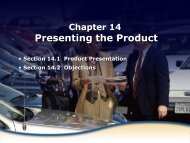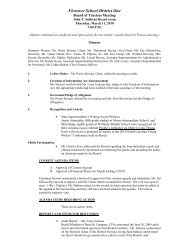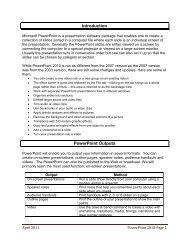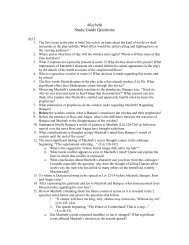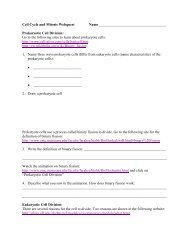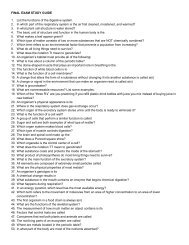PS-3.1 Distinguish chemical properties of matter (including reactivity ...
PS-3.1 Distinguish chemical properties of matter (including reactivity ...
PS-3.1 Distinguish chemical properties of matter (including reactivity ...
Create successful ePaper yourself
Turn your PDF publications into a flip-book with our unique Google optimized e-Paper software.
Properties and Classifications <strong>of</strong> Matter<strong>PS</strong>-<strong>3.1</strong> <strong>Distinguish</strong> <strong>chemical</strong> <strong>properties</strong> <strong>of</strong> <strong>matter</strong> (<strong>including</strong> <strong>reactivity</strong>) from physical<strong>properties</strong> <strong>of</strong> <strong>matter</strong> (<strong>including</strong> boiling point, freezing/melting point, density [withdensity calculations], solubility, viscosity, and conductivity).A physical property <strong>of</strong> a substance is a characteristic <strong>of</strong> the substance that can be observed directly ormeasured with a tool without changing the composition <strong>of</strong> the substance.A <strong>chemical</strong> property is a description <strong>of</strong> the ability <strong>of</strong> a substance to undergo, or not undergo, a change thatwill alter the composition <strong>of</strong> the original substance.Physical PropertiesBoiling point, freezing/melting point – students should Know that the terms boiling point and melting/freezing point do not refer to the phase change itself, but to ameasurement: the temperature at which these changes occur. The composition <strong>of</strong> a substance does not change during phase change nor does it change when one measurestemperature in order to determine the boiling point, and freezing point/ melting point, therefore, boilingpoint and melting/freezing point are physical <strong>properties</strong>. An increase in pressure will decrease the boiling point or the lower the freezing/melting point <strong>of</strong> asubstance.Density –Density is the mass <strong>of</strong> a substance per unit volume. The density <strong>of</strong> a particular substance (under constantconditions) is always the same, regardless <strong>of</strong> the sample size. The density <strong>of</strong> a substance changes with phase change because the volume usually increases with a phasechange. Density can not be measured directly, but is the ratio <strong>of</strong> two measurements: mass and volume. Use must know how to accurately measure the mass and volume <strong>of</strong> solids (regularly and irregularly shaped)and liquidsCalculate density using the formula: density = mass/volume.The composition <strong>of</strong> a substance does not change when one measures mass and volume in order to calculatedensity; therefore, density is a physical property.Solubility – A substance is soluble in a solvent if it will dissolve in that solvent. Solubility means “ the maximumamount <strong>of</strong> a solute (substance being dissolved) that can dissolve in a given volume <strong>of</strong> solvent (the dissolvingmedium) at a particular temperature and pressure”. A saturated solution is one in which the maximum mass <strong>of</strong> the solute is dissolved in the solvent at aparticular temperature. Be able to give examples <strong>of</strong> solids, liquids, and gases that readily dissolve in water and to realize that somematerials are not soluble in water. The components <strong>of</strong> solutions and other mixtures do not <strong>chemical</strong>ly combine to form a new substance.Solutions are composed <strong>of</strong> two substances which each retain their own <strong>properties</strong>. Therefore, solubility is aphysical property.1 / 10
Properties and Classifications <strong>of</strong> MatterViscosity – viscosity is a measure <strong>of</strong> the material’s resistance to flow. High-viscosity fluids take longer to pour thanlow-viscosity fluids. viscosity may change with temperature. the composition <strong>of</strong> a fluid does not change when it is poured and, therefore, viscosity is a physical property.Electrical Conductivity – The ability <strong>of</strong> a solid to act as an electrical conductor or an electrical insulator is based on the solid’s abilityto complete an electric circuit, i.e., conduct electricity Materials (such as metals) with high conductivity are called electrical conductors because they allow currentto flow easily. Materials with low conductivity are called electrical insulators because they do not allow current to flow.Most non-metals are insulators. Some solutions can conduct electric current. Solutes containing ions that dissolve in water that result insolutions that allow electric current to flow are called electrolytes.Chemical PropertiesA <strong>chemical</strong> property is a characteristic <strong>of</strong> a substance that indicates whether it can or cannot undergo acertain <strong>chemical</strong> change.A <strong>chemical</strong> change produces new substances with new identifying <strong>properties</strong>.Chemical <strong>properties</strong> include but are not limited to: Combustibility or flammability, such as carbon reacting with oxygen to form carbon dioxide. (example,burning charcoal), or hydrocarbons reacting with oxygen to form carbon dioxide and water vapor (example,burning <strong>of</strong> fossil fuels) Ability to oxidize, such as iron reacting with oxygen to form iron(III) oxide. (iron rusting) Ability to corrode, such as silver reacting with sulfur to form silver sulfide. (silver tarnishing) Ability to decompose, such as hydrogen peroxide decomposing into water and hydrogen gas when exposedto light. Ability to react with acids, such as zinc reacting with hydrochloric acid to form zinc chloride and hydrogengas. Ability to not react, such as gold being used in jewelry because it does not readily react.2 / 10
Properties and Classifications <strong>of</strong> Matter<strong>PS</strong>-3.2 Infer the practical applications <strong>of</strong> organic and inorganic substances on the basis <strong>of</strong>their <strong>chemical</strong> and physical <strong>properties</strong>.Select the best substance for a particular function when given a list <strong>of</strong> the substance’s <strong>chemical</strong> and physical<strong>properties</strong>. All organic substances are compounds that contain carbon, and that inorganic substances are elements orcompounds (that do not necessarily contain carbon).Organic Substances The functions <strong>of</strong> substances depend on their <strong>properties</strong>. Recall the names <strong>of</strong> selected types <strong>of</strong> organicbiological molecules and summarize how their functions in organisms are dictated by their <strong>chemical</strong><strong>properties</strong>. Examples include:○ Protein molecules are long chains <strong>of</strong> small units (amino acid monomers) that are arranged in variousconfigurations so they can form a wide variety <strong>of</strong> molecules. Proteins serve many varied functions inliving organisms such as catalysts (enzymes) and tissue building.○ Carbohydrate molecules (sugars and starches) provide organisms with energy when they break downinto smaller molecules.○ Lipid molecules (fats and oils) are good sources <strong>of</strong> stored energy because lipids produce more energyper gram than carbohydrates. Hydrocarbons are a class <strong>of</strong> organic molecules composed <strong>of</strong> the elements carbon and hydrogen. Carbon andhydrogen can combine to make thousands <strong>of</strong> different hydrocarbon compounds.○ Many hydrocarbons are combustible so they are used for fuel, <strong>including</strong> gasoline, kerosene, jet fuel, anddiesel oil.○ Many hydrocarbons form long chain molecules called polymers so they are used to make plastics andsynthetic fibers.Inorganic Substances Recognize potential uses <strong>of</strong> inorganic substances when given the <strong>properties</strong> <strong>of</strong> the substance. Examplesinclude:○ Copper is ductile and conducts electricity, so it is used in wiring.○ Aluminum has a low density compared to substances with similar strength, so it is used in makingairplanes.○ Water is a good solvent for many compounds, so it is used to wash clothes.○ Argon is an inert/stable gas that will not react with the filament, so it is used in light bulbs.<strong>PS</strong>-3.3 Illustrate the difference between a molecule and an atom.Elements are composed <strong>of</strong> only one type <strong>of</strong> atom.An atom is the smallest unit <strong>of</strong> an element that can be involved in a <strong>chemical</strong> reaction.All <strong>of</strong> the elements are listed on the periodic table.Molecular substances are composed <strong>of</strong> two or more atoms covalently bonded together to make units calledmolecules.A molecule is the smallest particle <strong>of</strong> a molecular substance that can exist and still have the composition and<strong>chemical</strong> <strong>properties</strong> <strong>of</strong> the substance.3 / 10
Properties and Classifications <strong>of</strong> Matter<strong>PS</strong>-3.4 Classify <strong>matter</strong> as a pure substance (either an element or a compound) or as amixture (either homogeneous or heterogeneous) on the basis <strong>of</strong> its structure and/orcomposition.Substances that have unique, identifying <strong>properties</strong> are called pure substances. There are two types <strong>of</strong> puresubstances, elements and compounds.○ An element is a pure substance which is composed <strong>of</strong> only one type <strong>of</strong> atom. All <strong>of</strong> the elements arelisted on the periodic table○ A compound is a pure substance which is composed <strong>of</strong> more than one type <strong>of</strong> element.• Compounds all have identifying <strong>properties</strong> which are different from the <strong>properties</strong> <strong>of</strong> the elementswhich compose them.• Compounds can be decomposed into elements only by <strong>chemical</strong> reactions; they can not be separatedinto elements by physical means.• Compounds have a definite <strong>chemical</strong> composition identified by a <strong>chemical</strong> formula. For example,the ratio <strong>of</strong> the number <strong>of</strong> oxygen atoms to hydrogen atoms in any sample <strong>of</strong> water is always 1 to 2.• Molecular substances are one type <strong>of</strong> compound, and ionic substances are another type <strong>of</strong>compound.When <strong>matter</strong> is composed <strong>of</strong> two or more component substances which retain their own identifying<strong>properties</strong>, the <strong>matter</strong> is classified as a mixture.○ A mixture can be separated physically because the components <strong>of</strong> the mixture have different physical<strong>properties</strong>.○ Ways to separate mixtures based on differing <strong>properties</strong> include Dissolving Filtering Evaporating Decanting Magnetic separation Chromatography Separating by particle size (screening) Mixtures do not have definite composition; the components <strong>of</strong> a mixture may be in any ratio. Mixtures can be classified into two groups, heterogeneous and homogeneous.○ Heterogeneous mixtures do not have the components distributed evenly throughout. The differentcomponents are <strong>of</strong>ten easy to see in a heterogeneous mixture.Homogeneous mixtures have components evenly distributed all the way down to the particles, whetheratoms, molecules, or ions. The components are so small that they can not be seen with the naked eye. Asolution is a homogeneous mixtureMixtures can occur between and among all phases <strong>of</strong> <strong>matter</strong>:○ Gas/gas (air)○ Gas/liquid (oxygen in water)○ Liquid/liquid (alcohol in water)○ Solid/liquid (sugar in water)○ Solid/solid ( alloy such as steel)4 / 10
Properties and Classifications <strong>of</strong> Matter.MatterPureSubstanceMixtureCannot be separatedusing physical <strong>properties</strong>Component particles havethe same <strong>properties</strong> as thesubstanceComponents in definiteproportionsSeparated using physical<strong>properties</strong>Components retain theirown <strong>properties</strong>, differentfrom substanceComponents not indefinite proportionsElementCompound Heterogeneous HomogeneousComposed <strong>of</strong>only oneelementComposed <strong>of</strong>more than onetype <strong>of</strong> elementComponentsnot evenlydistributedComponentsevenlydistributedFound on theperiodic tableNot one <strong>of</strong> theelements foundon the periodictableComponentscan be seenComponentparticles toosmall to beseen5 / 10
Properties and Classifications <strong>of</strong> Matter<strong>PS</strong>-3.5 Explain the effects <strong>of</strong> temperature, particle size, and agitation on the rate at whicha solid dissolves in a liquid.Three basic assumptions <strong>of</strong> kinetic theory.○ All <strong>matter</strong> is composed <strong>of</strong> small particles (molecules, atoms, and ions).○ The particles are in constant, random motion.○ The particles are colliding with each other and the wall <strong>of</strong> their container.Process <strong>of</strong> dissolving in terms <strong>of</strong> the kinetic theory.○ The solvent (in this case water) is composed <strong>of</strong> individual water molecules (H 2 O), all close enough totouch, but in constant motion, moving over, under, and past one another.○ The solute (such as table sugar) is composed <strong>of</strong> crystals.• Each crystal is composed <strong>of</strong> billions <strong>of</strong> individual sugar molecules. The individual molecules areattracted to each other (not <strong>chemical</strong>ly bonded) together. The sugar molecules in the crystal are alsomoving but because sugar is a solid the molecules do not move past each other, they vibrate in place.• Because sugar is a molecular compound, the individual sugar molecules can not be decomposed by aphysical process such as dissolving, so the dissolved sugar remains as sugar molecules and notseparated carbon, hydrogen and oxygen atoms.• The dissolving process involves the sugar molecules being pulled away from each other by the watermolecules but each molecule <strong>of</strong> sugar remains intact.• The sugar molecules on the surface <strong>of</strong> the crystal are the only ones to dissolve because they are theones in contact with the water molecules. As surface sugar molecules dissolve, they expose the onesbeneath to the water.• Because the dissolved sugar molecules are surrounded by water molecules, they are not attracted toeach other (the water molecules block the attractive force).• In the resulting solution, the sugar molecules are distributed throughout the water.• The water can be removed by boiling the water or allowing it to evaporate. When the water boils orevaporates away, the sugar molecules will once again be attracted to each other and sugar crystalswill reform.Temperature affects the rate at which substances dissolve.○ The higher the temperature, the faster the rate <strong>of</strong> dissolving for a solid in a liquid.○ At higher temperatures more <strong>of</strong> the solvent molecules are moving faster and collisions with the surface<strong>of</strong> the solute occur more <strong>of</strong>ten carrying <strong>of</strong>f particles <strong>of</strong> the solute so dissolving occurs more rapidly.Particle size affects the rate at which substances dissolve.○ The smaller the size <strong>of</strong> the pieces <strong>of</strong> solute, the faster they dissolve.○ The smaller the size <strong>of</strong> the individual pieces, the more surface area the sample will have to be in contactwith the water molecules. With more surface area in contact the water molecules, the water will havemore opportunities to pull the solute molecules away from the solute’s surface, thereby, dissolving itfaster.Agitation (stirring or shaking) affects the rate at which substances dissolve.○ The more the solution is agitated, the faster the rate <strong>of</strong> dissolving for a solid in a liquid.○ When a solution is agitated, the water particles collide with the surface <strong>of</strong> the solute more frequently andthe dissolving process occurs faster.If a substance is soluble in water, it will eventually dissolve even if the size <strong>of</strong> the sample pieces <strong>of</strong> soluteare large, the temperature is low and there is no agitation.Do not confuse the rate <strong>of</strong> dissolving (how fast a substance dissolves) with solubility (the degree to which onesubstance is able to dissolve in another –ex. Oil(nonpolar) does not dissolve in water(polar); alcohol doesdissolve in water because both are polar)6 / 10
Properties and Classifications <strong>of</strong> Matter<strong>PS</strong>-3.6 Compare the <strong>properties</strong> <strong>of</strong> the four states <strong>of</strong> <strong>matter</strong>—solid, liquid, gas, andplasma—in terms <strong>of</strong> the arrangement and movement <strong>of</strong> particles.Kinetic theorySolidsLiquidsGasesPlasma The particles <strong>of</strong> solids are closely packed together because there is an attractive forceholding them together The particles <strong>of</strong> solids are constantly vibrating, but they do not readily slip past oneanother. Because the particles vibrate in place and do not readily slip past one another, a solid hasa definite shape. The particles <strong>of</strong> liquids are in contact with each other because there is an attractive forceholding them together. The particles <strong>of</strong> liquids have enough energy to partially overcome the attractive force <strong>of</strong>the surrounding particles. Liquid particles can slip past surrounding particles and slideover one another. Because the particles slip past one another, a liquid does not have adefinite shape and so takes the shape <strong>of</strong> the container. A sample <strong>of</strong> a liquid can bepoured. The particles <strong>of</strong> gases are not in contact with each other because they have enough energyto completely overcome the attractive force between or among the particles. The particles <strong>of</strong> gases are moving randomly, in straight lines until they bump into otherparticles or into the wall <strong>of</strong> the container. When a particle hits another particle or thecontainer, it bounces <strong>of</strong>f and continues to move. Because gas particles move independently, the particles move throughout the entirecontainer. The forces between the particles are not strong enough to prevent the particlesfrom spreading to fill the container in which the gas is located. Plasma is <strong>matter</strong> consisting <strong>of</strong> positively and negatively charged particles. A substance is converted to the plasma phase at very high temperatures, such as those onin stars (such as the sun). High temperature means that the particles <strong>of</strong> a substance aremoving at high speeds. At these speeds, collisions between particles result in electronsbeing stripped from atoms. Plasma is the most common state <strong>of</strong> <strong>matter</strong> in the universe, found not only in stars, butalso in lightning bolts, neon and fluorescent light tubes and auroras.Be Careful! At a given temperature, all <strong>matter</strong> has the same average kinetic energy. In each sample there areparticles moving at all different rates <strong>of</strong> speed. As temperature increases, more particles move fast, fewerparticles move slowly. The reason that various types <strong>of</strong> <strong>matter</strong> are in various phases at a given temperature isprimarily due to the variation in the strength <strong>of</strong> the forces between the particles <strong>of</strong> various substances.Materials change phase when they absorb enough energy to break/overcome the attractions between theparticles <strong>of</strong> which they are composed.7 / 10
Properties and Classifications <strong>of</strong> Matter<strong>PS</strong>-3.7 Explain the processes <strong>of</strong> phase change in terms <strong>of</strong> temperature, heat transfer, andparticle arrangement.Temperature is a term used to describe the average kinetic energy <strong>of</strong> the particles in a substance. In asample <strong>of</strong> material at any temperature there are particles moving at all speeds. Temperature is a measure <strong>of</strong>the average motion <strong>of</strong> the particles. At higher temperatures, more <strong>of</strong> the particles are moving fast and atlower temperatures, more <strong>of</strong> the particles are moving slowly.Phase change in terms <strong>of</strong> the kinetic theory.○ Phase change is due to changing the freedom <strong>of</strong> movement <strong>of</strong> the particles by the addition <strong>of</strong> energy.○ The freezing/melting point is the temperature where a phase change occurs as both the liquid and solidphases exist in equilibrium with each other. If heat energy is being added at this temperature, bondsbetween particles will break and a solid will melt. If heat energy is being taken away, bonds will formbetween particles and a liquid will freeze at this temperature.○ The boiling point is the temperature where a liquid is changing to a gas throughout the liquid.Evaporation at the surface <strong>of</strong> a liquid can occur at any temperature. However, at the boiling pointbubbles <strong>of</strong> the vapor are formed throughout the sample and rise to the top and escapes at which point thesample is said to be boiling.When energy (such as heat) is added to a substance, the energy <strong>of</strong> the particles <strong>of</strong> the substance increases.Evidence <strong>of</strong> this would be that: (1) the temperature <strong>of</strong> the substance increases, or (2) a phase change occurs.When heat is added to a solid the particles will move faster and the temperature will increase until thetemperature <strong>of</strong> the solid reaches its melting point.○ When the temperature <strong>of</strong> a solid is equal to the melting point and more heat is added to the substance,the temperature will not change. The extra heat will be used to break some <strong>of</strong> the bonds between themolecules <strong>of</strong> the solid and change the phase to a liquid.When heat is added to a liquid the particles will move faster and the temperature will increase until thetemperature <strong>of</strong> the liquid reaches its boiling point.○ When the temperature <strong>of</strong> a liquid is equal to the boiling point and more heat is added to the substance,the temperature will not change. The extra heat will be used to break the bonds between the molecules<strong>of</strong> the liquid and change the phase to a gas. When a substance boils, it forms bubbles <strong>of</strong> the gas. (Forexample when water boils, the bubbles are filled with water vapor.) The changes shown on a temperature versus time graph that shows boiling point and melting/freezing point.○ The line <strong>of</strong> the graph has a positive slope until a phase change occurs.○ At the melting point or boiling point the temperature does not change as more heat is added over time.The slope <strong>of</strong> the line will be flat during the time that the phase is changing.○ After the phase change the slope <strong>of</strong> the line becomes positive again.8 / 10
Water with Heat Added Over TimeProperties and Classifications <strong>of</strong> Mattertime (s)Liquids may evaporate at any temperature. This is because some <strong>of</strong> the molecules at the surface are movingfast enough to escape the attraction <strong>of</strong> the other molecules.Solids may undergo the process <strong>of</strong> sublimation, a process that involves particles changing directly fromthe solid phase to the gaseous phase. This is a process similar to evaporation that takes place at the surface<strong>of</strong> the solid.o An example <strong>of</strong> sublimation is seen when dry ice (solid carbon dioxide) disappears as it changes directlyto gaseous carbon dioxide without melting first.o The opposite <strong>of</strong> sublimation is deposition.Heat and temperature are not the same thing!o A huge pot <strong>of</strong> very hot water and a c<strong>of</strong>fee cup <strong>of</strong> very hot water can both have the same temperature, butthe pot <strong>of</strong> water contains much more heat energy than the water in the cup because the mass <strong>of</strong> the waterin the pot is so much greater.9 / 10
Properties and Classifications <strong>of</strong> Matter<strong>PS</strong>-3.8 Classify various solutions as acids or bases according to their physical <strong>properties</strong>,<strong>chemical</strong> <strong>properties</strong> (<strong>including</strong> neutralization and reaction with metals),generalized formulas, and pH (using pH meters, pH paper, and litmus paper).One <strong>of</strong> the important working definitions <strong>of</strong> an acid is a <strong>chemical</strong> that releases hydrogen ions (H + ) in solutionand that a base is a <strong>chemical</strong> which releases hydroxide ions (OH - ) in solution. The pH scale is a way to measure the concentration <strong>of</strong> hydrogen ions in solution. It measures how acidic orhow basic a solution is.○ The pH <strong>of</strong> a solution can be measured using pH paper, litmus paper, or pH meters.○ The pH range <strong>of</strong> many solutions falls between 0 and 14.○ The pH <strong>of</strong> pure water is 7. Any solution with a pH <strong>of</strong> 7 contains equal concentrations <strong>of</strong> H + and OH -and is considered a neutral solution. It is not an acidic or a basic solution.○ The pH <strong>of</strong> an acidic solution is less than 7. It contains more H + than OH - . A lower number indicatesmore hydrogen ions (H+). The lower the number the more acidic the solution.○ The pH <strong>of</strong> a basic solution is greater than 7. It contains less H + than OH - . A higher number indicatesmore hydroxide (OH - ) ions. The higher the number the more basic the solution is. Physical and <strong>chemical</strong> <strong>properties</strong> <strong>of</strong> acidic solutions.○ Acidic solutions conduct electricity because the contain ions (They are electrolytes).○ Acidic solutions have a tart or sour taste○ Acidic solutions turn blue litmus paper red.○ Acidic solutions have a pH less than 7.○ Acids react with active metals such as zinc and magnesium.○ The formula <strong>of</strong> an acid can be recognized because the first element in the formula is hydrogen.Examples:• HCl Hydrochloric acid (stomach acid)• H 2 SO 4 Sulfuric Acid (common industrial acid)• Physical and <strong>chemical</strong> <strong>properties</strong> <strong>of</strong> basic solutions.○ Basic solutions have a slippery feel○ Basic solutions conduct electricity because they have OH - ions (electrolytes)○ Basic solutions have a pH greater than 7○ Red litmus paper turns blue in the presence <strong>of</strong> a basic solution○ The formula <strong>of</strong> a base can be recognized because the formula ends in OH.○ Examples might include.• NaOH Sodium Hydroxide (drain cleaner)• Ca(OH) 2 Calcium Hydroxide (hydrated lime - fertilizer) Neutralization:○ Acids and bases react to form water and a salt. This type <strong>of</strong> reaction is <strong>of</strong>ten called a neutralizationreaction because the hydrogen ions from the acid and hydroxide ions from the base react to form watermolecules (water is neutral).○ An acid is used to neutralize a base; a base is used to neutralize an acid.10 / 10







